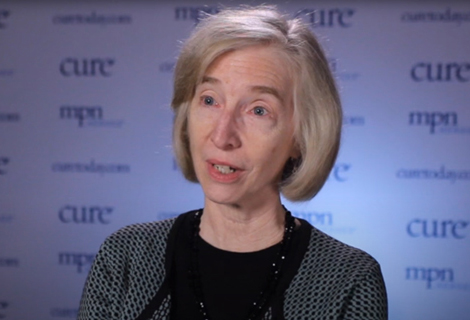Our research impact
Over our 24-year history, MPN Research Foundation has funded and supported groundbreaking research that has expanded the medical community’s understanding of MPNs and led to the development of more effective therapies.
MPNRF has invested $18.9 million total dollars,
supported 90 researchers across 9 countries, and funded 99 projects.
Key research projects
CALR mutation
MPNRF funded one of the two teams that discovered the CALR mutation. This provided answers for patients who do not have the JAK2 mutation.
Key research projects
Driver mutations
We funded the first study to locate and identify genes that lead to MPNs, as well as groundbreaking research showing MPN driver mutations were often acquired decades before diagnosis.
Key research projects
JAK2 research
Our investment helped identify preclinical drug candidates that selectively target JAK2 mutated cells.
Key research projects
Disease progression
Leveraging our neutral role at the center of the MPN community, we’re leading the charge for research that will slow, stop, or reverse disease progression.
Key research projects
Interferon Research
Our investment helped advance the understanding of interferon and how individual patients respond to it.
Commitment to Investing in MPN Research
MPN leaders on our research impact



“As we chart the course for the next 20 years, we will continue to convene global thought leaders to help steer our vision for future promise of disease treatment and prevention, and the clinicians, researchers, industry leaders, patients and their advocates will help us invest our funds for the most impactful outcomes. That means new treatments, new options, better quality of life, and ultimately prevention of progression.
We will continue to invest in our core principles for high risk, high reward research with near-term outcomes. At the same time, we’ll be setting our future on a path of innovation toward aspirational, long-term and sustainable outcomes for ET, PV, and MF patients.”
— Kapila Viges, MPNRF Chief Executive Officer

Our
mission
MPN Research Foundation stimulates original research in pursuit of new treatments — and eventually a cure — for the blood cancers polycythemia vera, essential thrombocythemia, and myelofibrosis, known collectively as myeloproliferative neoplasms (MPNs).
Through a combination of investing in innovative research, advocating for the patient voice, and convening the global MPN community, we bring together patients, researchers, and industry around the common goal of realizing new treatment options and, ultimately, cures for MPNs.

The foundation has played a key role in funding some of the more important work that has been done over the last two decades, translating ideas into meaningful impact for patients. For example, identification of some of the mutations that are involved in the disease, and specifically some of the driver mutations, these were in part funded by the foundation. We used to put all of our patients in one bucket, then say some are high risk, some are low risk. But now with the advent of all of the mutational work, it helps guide us in treatment decisions and outcome predictions.
Raajit Rampal, MD, PhD
Sloan Kettering Cancer Center and MPNRF Scientific Advisor
Our leadership
Message from Barbara Van Husen, MPNRF Board Chair
When in 2005 the single point gene mutation associated with MPNs was discovered (Jak2 V617F), we were convinced this would change everything. And, in fact, it has. From the challenge of finding someone who could spell myeloproliferative disorder (now neoplasm), MPNs are now among the hottest things on the blood cancer front.
Today, we have so many research thought leaders knocking on our proverbial doors, we have to decide with whom and how most effectively to invest our precious, hard won dollars.
For more than three years, we funded researchers to pound away at preclinical testing for JAK inhibitors. We funded very early full genome sequencing projects at a time when the human genome project first suggested this might be feasible. One of the projects we funded resulted in identification of a new MPN driver mutation called Calreticulin (CALR), which we now know accounts for the one-third of MPN cases not associated with Jak2.
In fact, a significant number of MPNRF research projects resulted in major scientific findings. And some of the people who received our earliest awards to new investigators are now leaders in the field.
While we’re proud of every one of our wins, we won’t rest on our laurels. As most people who are involved with MPNs know, these are chronic, complicated, heterogeneous diseases. And until we are confident that all MPN patients have treatment options that will change their disease, we’re not done.
“In our early years, MPNs were on nobody’s radar. We placed ads in medical journals: ‘We want to fund research into myeloproliferative disorders. Come and get it!’ We expected a stampede for dollars. The first year, we had two submissions.”
When we held our first MPN Roundtable in 2012, we brought together investigators with very different perspectives. We just sat back and listened to the fireworks fly. The scientists said they had never been to a meeting like this, where across the table was a colleague who was approaching the same problems, possibly in completely different ways, yet they had not ever spoken. The dynamics and sidebar conversations of the annual roundtables remain extraordinary.
— Barbara Van Husen, MPNRF Board Chair

Patient Impact: Cathy
Cathy’s grandkids know she has a ‘blood problem.’ They also know that a lot of dedicated individuals are working to understand how to make her better. In the meantime, despite the daily fatigue and a series of life-threatening blood clots, Cathy exemplifies why answers to preventing and treating symptoms and dangerous complications are as critical as a cure.

Our research impact
We’ve awarded more than $18.9 million for MPN blood cancer research since 2000.
This investment continues to accelerate our understanding of MPNs — their causes, prevention, and progression. Our primary goal: the development of new treatment options, improving patients’ quality of life, and ultimately a cure.

From lab to clinic
Johns Hopkins Medicine
Memorial Sloan Kettering

It is unusual that we have been effectively using interferon for the treatment of MPNs for more than 30 years without fully understanding how it works. That is why the MPNRF’s Interferon Initiative is so important. Interferon appears to uniquely affect the MPN stem cells and has other valuable attributes.
Richard T. Silver, MD
Director Emeritus, Silver MPN Center at Weill Cornell Medicine
Patient Impact: Taja
Despite being told there were potential serious risks to a pregnancy with her PV, Taja followed the science, the advice of MPN specialists, and her dream. She gave birth to her daughter, Miracle, in 2020. In the year that followed, she was diagnosed with myelofibrosis, hospitalized twice for blood clots in her heart and lungs, and late in 2021 had a stem cell transplant, the only current cure for an MPN.
“This photo was a good day for me. The issue with MPN is that it is invisible and it’s hard for you or anyone to see exactly what you’re dealing with internally.”

Our future
Leaders don’t just set goals, they understand the power of results. That’s the ethos that defines the MPNRF. It’s what propels us. It’s an unwavering commitment to deliver on answers from the lab to the treatment room. And it keeps us laser focused on our mission.
What’s next for MPNRF?
We’re ready to drive another decade of tremendous impact.
We’ll focus on targeted laboratory, clinical and translational research funding, and coordination of talented investigators around the globe, including both renowned MPN researchers and those just jumping in to explore these rare blood cancers.
We’ll gather them together, talk openly about what we’ve learned, and discuss how their groundbreaking work might translate to clinical trials — with hope for new and better treatments for MPNs.
We’ll actively support key research topics that have historically been underfunded. And we’ll keep at it until the questions we’ve been asking no longer remain unanswered.
We’re now leading a large research commitment to MPN progression. And as our understanding increases, we’re hopeful that new therapies down the road will be able to slow disease progression, or even prevent it. Our ultimate goal is to have little more to do — because MPNs are no longer a life-threatening blood cancer.
— Brandon Goetzman, MPNRF Board Member

Invest. Convene. Advocate.
Yes, we’re primarily a research foundation, but we also take our commitment to advocacy to heart. We convene all types of stakeholders to better inform and advocate for the specific needs of people living with MPNs. It may be advocating for more research dollars into ET, PV, or MF, or the urgency of approving more and better drug therapies. Our success reflects our broad reach and our commitment to bring together the voices of researchers and advocacy organizations from across the globe, government regulators, biopharma, and patients and their life and care partners.


MPN Challenge™
The MPN Challenge is our open request for research proposals which are diligently reviewed by scientific peers and leading experts. The focus areas change each round so we can fund the most pressing MPN science and respond to new unmet needs. Since 2012, we’ve funded studies into immunotherapy, selective JAK2 inhibition, inflammation, interferon and more. Five project awards announced in 2021 will each receive up to $200,000 over two years.
MPN Roundtable™
This isn’t just another scientific meeting. Since our initial MPNRF Roundtable in 2012, it has become an event that invited MPN research stakeholders, including patients, look forward to each year. The unique gathering results in vital, sometimes unexpected questions and conversations, and ultimately important collaborations between leaders in academia and industry.


MPN Voice of the Patient
This Patient Focused Drug Development Meeting with the FDA was a long awaited platform for the MPN community to convey the challenges that ET, PV, and MF patients face every day. Patients shared what it means to have an MPN diagnosis, which of their symptoms should be prioritized, and how their disease impacts their quality of life. A detailed report of the two-day meeting was delivered to the FDA in 2021, a collaboration with MPN Advocacy & Education International, The Leukemia & Lymphoma Society and MPN Cancer Connection.
Patient Impact: Ruth
When in 2019 MPNRF held an MPN patient focused informative meeting with the FDA, Ruth was on a patient panel. It was a first ever event, MPNRF advocating for more and better therapies for MPNs, and the first time Ruth shared her 30-year story of progression from ET to PV to MF. “I just want to dance at my son’s wedding,” she said. Three months later, she entered a clinical trial, then became a global MPN advocate. And in 2021, she beamed as her son Zach twirled her across the dance floor.

Our progress perpetuates our continued need
When Chicago businessman Robert Rosen was diagnosed with polycythemia vera in 1997, he had to search for information the old fashion way. He was shocked to discover how little research was conducted on myeloproliferative neoplasms – then called blood disorders.
So Rosen pulled together a small number of other MPN patients, established the MPN Research Foundation (then MPD Foundation) and set out to catalyze research leading to advanced treatments for people living with these rare blood conditions.
Today, after nearly 25 years of MPN leadership and research, our investments have paid off with extraordinary progress. While we celebrate our impact, we commit ourselves to continue to drive answers to the biology, treatment, and progression of MPNs.
“When my dad founded the MPN Research Foundation, little was known about these rare blood disorders and there was virtually no research being done. So he set out to change that. And the result 21 years later is astounding!”
— Rebecca Rosen Shapiro

